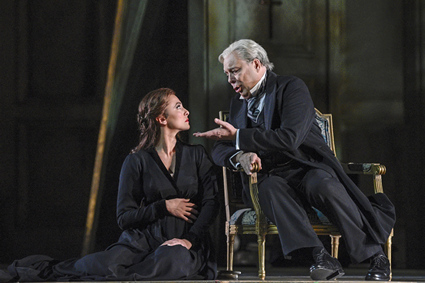| Opera Reviews | 24 April 2024 |
Pelléas et Mélisande casts a powerful spellby Steve Cohen |
|
Debussy: Pelléas et Mélisande |
|

Isabel Leonard (Mélisande), Ferruccio Furlanetto (Arkel)
|
|
|
To get the most out of Pelléas et Mélisande you need to immerse yourself in its strange world. It is possible to enjoy this opera sober, but it might be enhanced if you’re floating on drugs. The plot is an elusive compendium of ambiguity, while the music is dreamlike, wispy and atmospheric. One thing that’s unambiguous: Pelléas et Mélisande does cast a powerful spell. Pelléas et Mélisande is an exemplar of Symbolism, that literary movement which uses indirection to express states of mind. Maurice Maeterlinck was a prime exponent in France in the 1890s. He set this, his most-remembered play, in a shadowy kingdom called Allemonde, from the German word for “all” and the French word for “world.” Yet this is the least recognizable land you’ve ever seen. Even before Claude Debussy met Maeterlinck, the composer dreamed of this type of opera. In an 1890 letter to the composer Ernest Guiraud he wrote that he pictured “a poet who half speaks things…related dreams…no country, no date…characters who do not discuss.” His music copies the naturalness of speech and omits arias and ensembles. The protagonists keep their feelings hidden, and it’s left to Debussy’s orchestra to reveal the emotions. As Simon Rattle has said, characters don’t say what’s on their mind but the orchestra tells us what they’re feeling. The score is a diaphanous masterpiece with infinite gradations across its four-hour length. Every section of the orchestra has something to contribute — even brass and percussion, although they are used subtly. This opera has attracted eminent conductors, including Rattle in the last Met revival in 2011, and now Yannick Nézet-Séguin, who brings a dark approach, hushed and transparent yet stressing a deep sound. The notes, of course, are not lowered, but when we hear the strings it’s the base line that seems most powerful with the double-basses and celli providing the predominant tone. And the woodwinds seem to be using dark-sounding reeds. Yannick — as he likes to be called — is conducting these days without a baton, at Philadelphia Orchestra concerts and even in the Met’s huge pit. He says it gives him more ability to express emotions, and that surely was evident here. The outstanding on-stage performance comes from Kyle Ketelsen, a bass-baritone from Iowa as Goloud, the prince who meets Mélisande in the woods and marries her, only to see her fall in love with his younger half-brother Pelléas. His powerful singing and acting remind us that Goloud actually is the central character in this drama — a decent man who is so insecure that his jealousy drives him to murder. Isabel Leonard as Mélisande is appealing with the extremely difficult part of a reticent teenager. Her singing is lovely as she reigns in her normally rich mezzo voice. The advantage of having a tenor sing the role of Pelléas is its suggestion of youth and innocence. Indeed, his declaration of love rings out convincingly in the last act. But most of the role lies in a low-middle range where Paul Appleby’s voice lacks projection. (The Met’s last previous performances of the opera used baritone Stéphane Degout as Pelléas.) Appleby’s dramatic interpretation, regrettably, has little definition. The Italian bass Ferrucio Furlanetto is superb as the blind and aged Arkel. His majestic bearing and sonorous voice is impressive. Boy soprano A. Jesse Schopflocher persuaded me that females need not be cast as Goloud’s young son, because he sings the role so sweetly while he looks the part. I attended the January 22 performance, where everyone’s singing was better than the production’s opening night which I heard streaming on Sirius, when most other critics reviewed it. I am an admirer of Jonathan Miller’s talents as a director, but this 1995 production by him leaves much to be desired. The massive sets by John Conklin and formal Edwardian costumes resemble the period of the opera’s composition (1902) rather than the prescribed medieval fairytale land. There’s no forest, no grotto, no castle tower, and nothing explains the frequent mentions of light versus darkness. The lumbering sets overwhelm the delicate nature of the opera. Pelléas et Mélisande is revived in New York only once every eight years or so, and for brief engagements (five performances this year.) It doesn’t do well at the box office, and some subscribers leave at intermission. Therefore it may not earn a big investment in an expensive new production. But the opera is deserving of a creative mounting, perhaps using simple projections And I wish this production, because it’s so well sung and conducted, had been included in the Met’s HD season in movie theaters. It deserved wider exposure.
|
|
| Text © Steve Cohen Photo © Karen Almond / Met Opera |
|







